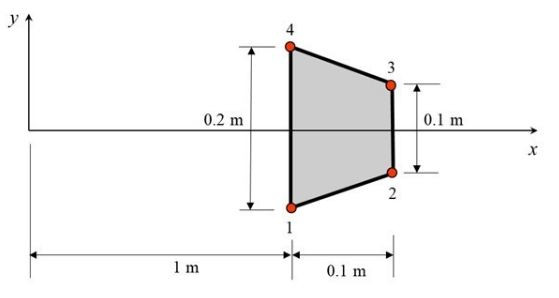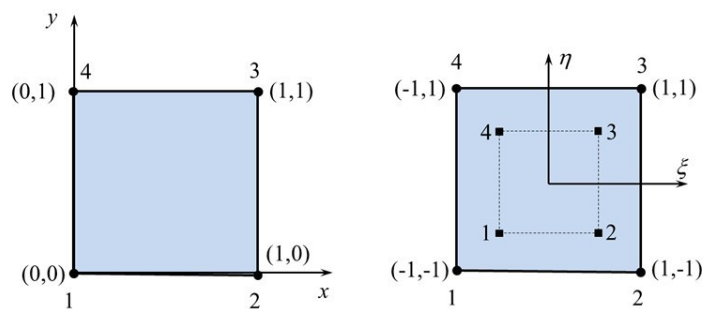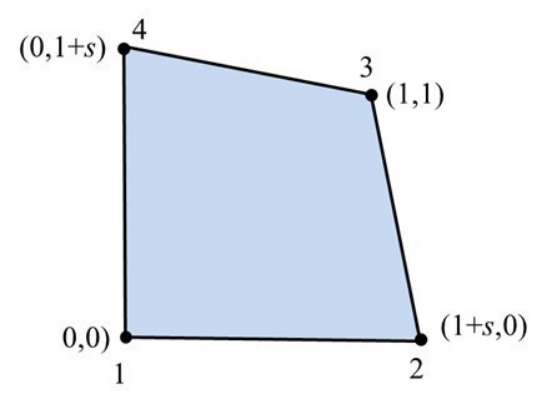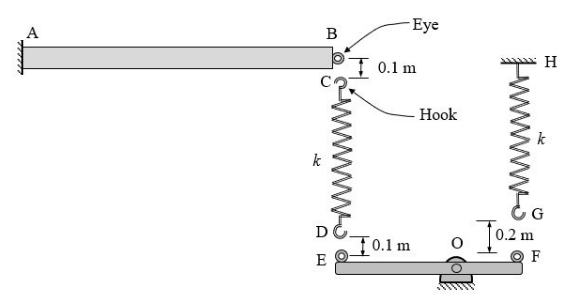| Category | Assignment | Subject | Education |
|---|---|---|---|
| University | Nanyang Technological University (NTU) | Module Title | MA7131 Finite Element Method |
| Academic Year | 2025/26 |
|---|
1. Figure 1 shows an axisymmetric solid where y-axis is the axis of symmetry and the cross-section is a trapezium. The cross-section is modelled as a single 4-node quadrilateral isoparametric element as shown.

Figure 1
The radial displacements in metres (along x-axis) of nodes have been determined to be 0.001,
9.6811×104, 9.6811×104 and 0.001, for nodes 1,2, 3 and 4, respectively. The axial displacements
in meters (along y-axis) are 2.5964×105, 1.4188×105, 1.4188×105 and 2.5964×105, respectively. The Young’s modulus of the material is 200 GPa and the Poisson’s ratio is 0.3.
(a) Using B-matrix and generalized Hook’s Law, determine the strain and stress components at all the 2×2 Gauss point locations. Thereby determine the strain energy stored in the element by 2×2 Gaussian integration.
(10 marks)
(b) Determine the mass moment of inertia Iyy by 2×2 Gaussian integration. (Obtain the necessary formula Iyy by referring to books or internet. Cite references.) Take the mass density to be 7850 kg/m3.
(10 marks)
2. Figure 2(a) shows a 4-node quadrilateral isoparametric element. The nodal coordinates of the element in physical space as (x1, y1) = (0, 0), (x2, y2) = (1, 0), (x3, y3) = (1, 1) and (x4, y4) = (0, 1). These coordinates correspond to a square (un-distorted) element shape. Now, let us introduce element shape distortion as shown in Figure 2(b) by redefining the nodal coordinates of nodes 2 and 4 as (x2, y2) = (1s, 0) and (x4, y4) = (0, 1s) where s is a real parameter: 1< s <2. (The shape of the element in the local coordinate space is a square as usual.)

Figure 2(a)

Figure 2(b)
It is intended to study for what values of s (both positive and negative), the value of |J| becomes zero within the element as well as outside the element. Obtain an expression for |J| in terms of s, and . For typical values of s (chosen by you), draw contour lines in the - plane along which |J| is zero.
(20 marks)
Seeking with your MA7131 Assignment? Deadlines Are Near?
Request to Buy Answer3. Figure 3 shows a uniform beam AB of length L = 1 m and bending rigidity EI = 105 Nm2 fixed to a rigid wall at end A. There are three pairs of ‘hooks’ and ‘eyes’ as shown. EOF is a rigid beam (and can only undergo rotational motion about O). The distance EO is twice of OF. The two springs shown have the same stiffness k = 5×105 N/m. The three hooks are assembled onto the hooks gently. Model the beam using a single 2-noded beam element having two degrees of freedom per node (i.e., vertical displacement and cross-sectional rotation).

Figure 3
First, assemble the element stiffness matrices to obtain the global equations (for the assembly). Then, apply the boundary conditions associated with supports at A and H using the elimination method. Then apply the multi-point contraints (associated with the assembling of hooks with the eyes) by penalty method. Choosing appropriate values for the penalty constants, solve the resulting equations for the vertical displacement of the beam at B so that the displacements are accurate up to 4 significant figures.
(20 Marks)
4. Consider the problem of steady state heat conduction through a framed structure (see Figure 4) consisting of 11 beam members of equal length of 1 m and cross-sectional area 0.01 m2 with all members joined together by welding. The (acute) angle between any two beam members is 60 degrees. For the finite element modelling, you are required to use a single 2-node (linear) heat conduction element to model each beam member. Joint A is at a constant temperature of 100 oC while joint D is at 50 oC. Each rod gains heat from the surrounding at the rate of 100 W/m (heat source). Take the thermal conductivity of the rod material as 100 Wm-1 oC -1.
Determine the nodal temperatures of the framed structure. Determine how much heat enters/leaves the structure through joints A and D. Also determine the heat flow rate and direction in each rod.
Show all these results pictorially on a neat sketch of the framed structure.

Figure 4
(20 Marks)
5. Figure 5 below shows a structure made up of a straight uniform beam AB of length 2 m, bending rigidity EI = 105 Nm2 and mass 40 kg connected to a solid disc of mass 100 kg, radius 0.1 m2 and thickness 0.01 m. The lengths portions AB and BC are equal, and each of these portions is to be modelled by a single beam element having two degrees of freedom per node (i.e., vertical displacement and cross-sectional rotation).

Figure 5
Use HRZ lumped mass matrix for the beams. Write the stiffness and mass matrices for the finite elements, assemble them to obtain the system (stiffness and mass) matrices, apply the boundary conditions to reduce the size of the these matrices, and thereby write the eigenproblem for the free vibration analysis of the structure.
Solve the eigenproblem to find an estimate of the smallest natural frequency (in Hz) of the structure accurate up to 4 significant figures by performing inverse iterations using a starting vector whose entries are all equal to unity.
(20 marks)
Hire Experts to solve MA7131 Assignment Before Deadline
Pay & Buy Non Plagiarized AssignmentHaving trouble with your MA7131 Finite Element Method Assignment? SG Assignment Help is available to assist you! Our skilled staff provides dependable free assignment samples catered to your requirements, whether you require professional advice for Functional Genomics or assistance refining your essays. Don't let deadlines worry you; get excellent help now and confidently turn in your best work. For individualised, prompt assistance, get in touch with Assignment Help right now!
Hire Assignment Helper Today!
Let's Book Your Work with Our Expert and Get High-Quality Content
